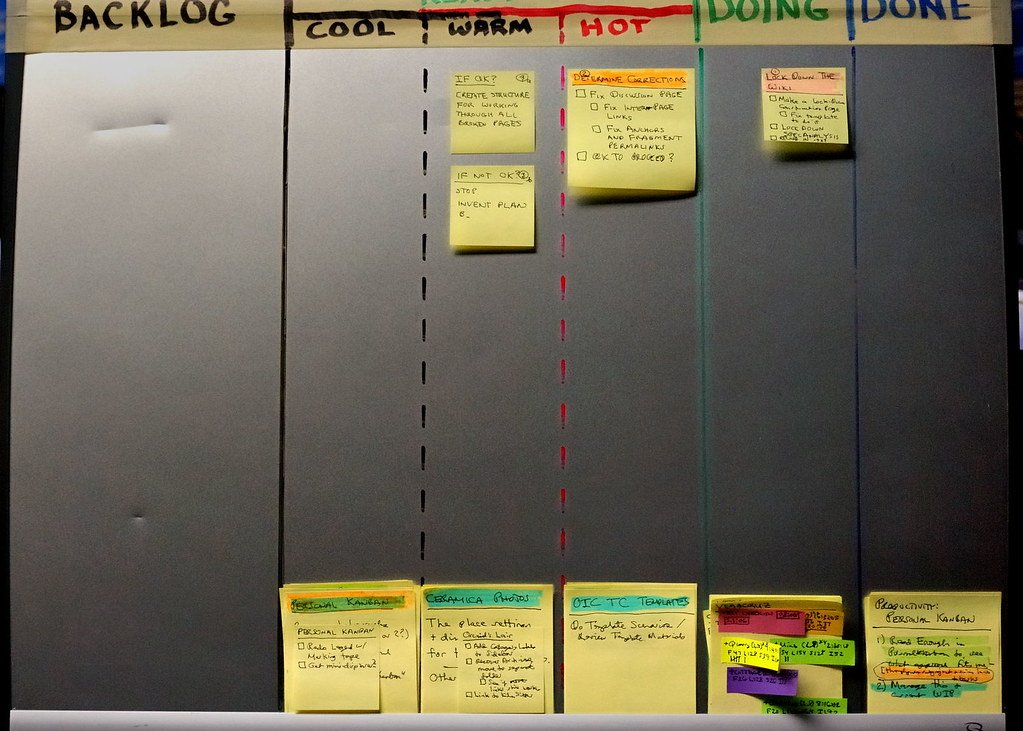In a world where remote work has become the new norm, finding effective ways to manage projects and stay organized is crucial. Enter the Kanban method, a visual framework that has revolutionized the way teams collaborate and streamline their workflows. Originally developed by Toyota in the 1940s, Kanban has since evolved into a versatile tool that can be adapted to any industry or work environment. Whether you’re a seasoned remote worker or just starting out, this article will guide you through the ins and outs of using the Kanban method to enhance your productivity, foster team communication, and conquer the challenges of remote work. So grab your virtual sticky notes and let’s dive into the world of Kanban for remote work!
Table of Contents
- Introduction: Understanding the Kanban Method for Remote Work
- Benefits of Implementing the Kanban Method in Remote Work Environments
- Key Principles and Practices for Effective Kanban Implementation in Remote Work
- Tips for Adapting the Kanban Method to Remote Work Challenges
- Best Tools and Technologies to Support Kanban in Remote Work Environments
- Q&A
- In Summary

Introduction: Understanding the Kanban Method for Remote Work
As remote work becomes increasingly prevalent, it is essential to adopt effective methodologies to ensure productivity and collaboration. One such method that has gained popularity is the Kanban method. Originally developed by Toyota in the 1940s, Kanban is a visual workflow management system that helps teams prioritize tasks, track progress, and optimize their workflow.
With the Kanban method, remote teams can easily visualize their work and identify bottlenecks, allowing for better coordination and smoother project execution. By utilizing a Kanban board, which typically consists of columns representing different stages of work and cards representing individual tasks, teams can easily track the status of each task and allocate resources accordingly.
Moreover, the Kanban method promotes a continuous improvement mindset, encouraging teams to regularly reflect on their processes and make adjustments for increased efficiency. By embracing this methodology, remote teams can enhance their communication, streamline their workflows, and ultimately achieve their goals more effectively.

Benefits of Implementing the Kanban Method in Remote Work Environments
When it comes to remote work environments, the Kanban method offers a plethora of benefits that can enhance productivity and streamline workflows. Here are some key advantages:
- Improved visibility: Kanban boards provide a visual representation of tasks, allowing team members to easily track progress and identify bottlenecks. This transparency fosters collaboration and ensures everyone is on the same page, regardless of their physical location.
- Efficient task management: With Kanban, tasks are organized into clear columns, such as “To Do,” “In Progress,” and “Done.” This structure enables remote teams to prioritize work, allocate resources effectively, and maintain a steady workflow. It also helps individuals focus on completing one task at a time, reducing multitasking and increasing efficiency.
- Flexibility and adaptability: Remote work often requires teams to be agile and adaptable. The Kanban method allows for easy adjustments to priorities and deadlines, ensuring that remote teams can quickly respond to changing circumstances. By visualizing work in progress, it becomes easier to identify potential roadblocks and make necessary adjustments to keep projects on track.
Implementing the Kanban method in remote work environments empowers teams to collaborate effectively, stay organized, and adapt to evolving circumstances. By embracing this approach, remote teams can unlock their full potential and achieve optimal productivity.

Key Principles and Practices for Effective Kanban Implementation in Remote Work
Implementing Kanban in a remote work setting requires a thoughtful approach to ensure seamless collaboration and productivity. Here are some key principles and practices to consider:
- Clear Communication: Establishing open lines of communication is crucial for remote teams. Utilize digital tools and platforms to facilitate real-time communication, such as video conferencing, instant messaging, and project management software. Encourage team members to provide regular updates on their progress and any potential blockers they may encounter.
- Visualize Workflow: Kanban boards are an excellent way to visualize the workflow and track the progress of tasks. Create a virtual Kanban board using tools like Trello or Jira, allowing team members to easily see the status of each task, identify bottlenecks, and prioritize work accordingly.
- Set WIP Limits: Work-in-progress (WIP) limits help prevent overloading team members and ensure a smooth flow of work. Define realistic WIP limits for each stage of the workflow, limiting the number of tasks that can be in progress simultaneously. This promotes focus, reduces multitasking, and improves overall efficiency.
- Regular Stand-up Meetings: Conducting daily or weekly stand-up meetings is essential to keep everyone aligned and address any challenges. These meetings provide an opportunity for team members to share updates, discuss roadblocks, and collaborate on solutions. Encourage active participation and ensure that everyone has a chance to contribute.
- Continuous Improvement: Embrace a culture of continuous improvement by regularly reviewing and refining your Kanban process. Encourage team members to provide feedback and suggestions for optimizing workflows. Analyze metrics and data to identify areas for improvement and implement changes accordingly.
By following these key principles and practices, remote teams can effectively implement Kanban and enhance their productivity, collaboration, and overall success.
Tips for Adapting the Kanban Method to Remote Work Challenges
Working remotely has become the new norm for many teams, presenting unique challenges when it comes to implementing project management methodologies like Kanban. However, with a few adjustments and some creative thinking, you can successfully adapt the Kanban method to overcome these remote work challenges. Here are some tips to help you get started:
- Embrace digital Kanban boards: Replace physical boards with digital tools that allow real-time collaboration and visibility. Platforms like Trello, Asana, or Jira can help you create virtual Kanban boards that can be accessed by your entire team, no matter where they are located.
- Establish clear communication channels: Remote work requires effective communication to ensure everyone is on the same page. Utilize video conferencing tools, instant messaging platforms, and project management software to facilitate regular check-ins, clarify tasks, and address any blockers or questions that may arise.
- Set realistic expectations: Remote work can blur the boundaries between personal and professional life. Encourage your team to establish clear working hours and communicate their availability. Additionally, ensure that tasks are well-defined, prioritized, and have realistic deadlines to avoid overwhelm and burnout.
By implementing these tips, you can adapt the Kanban method to the challenges of remote work, fostering collaboration, transparency, and productivity within your team.
Best Tools and Technologies to Support Kanban in Remote Work Environments
In today’s rapidly evolving work landscape, remote work has become the new norm for many organizations. As teams adapt to this new way of collaborating, it is crucial to have the right tools and technologies in place to support efficient workflow management. Kanban, a popular project management methodology, can be effectively implemented in remote work environments with the help of various tools and technologies.
One of the best tools to support Kanban in remote work environments is Trello. This intuitive online platform allows teams to create Kanban boards, where tasks can be organized into different columns representing different stages of completion. With its user-friendly interface and real-time updates, Trello enables seamless collaboration and transparency among team members, regardless of their physical location. Additionally, Trello offers features such as task assignments, due dates, and file attachments, making it a versatile tool for remote Kanban implementation.
Another technology that can greatly enhance Kanban in remote work environments is video conferencing software like Zoom. While Kanban boards provide a visual representation of tasks, face-to-face communication is equally important for effective collaboration. Zoom’s high-quality video and audio capabilities enable teams to conduct virtual meetings, discuss project updates, and address any challenges or roadblocks. By combining the visual aspect of Kanban boards with real-time communication, teams can ensure that everyone is on the same page and working towards common goals.
In addition to these tools, utilizing cloud storage solutions like Google Drive or Dropbox can further support Kanban in remote work environments. These platforms allow teams to store and share project-related documents, ensuring that everyone has access to the latest versions. With the ability to collaborate on files in real-time, teams can seamlessly integrate their work with the Kanban methodology, promoting productivity and efficiency.
In conclusion, the are Trello, Zoom, and cloud storage solutions. By leveraging these tools, teams can effectively implement Kanban methodologies, foster collaboration, and streamline workflow management, regardless of their physical location. Embracing these technologies will undoubtedly contribute to the success of remote teams in achieving their project goals.
Q&A
What is the Kanban Method?
The Kanban Method is an agile project management approach that focuses on visualizing work, limiting work in progress, and optimizing workflow. It helps teams to improve efficiency, collaboration, and transparency.
How can the Kanban Method be adapted for remote work?
For remote work, the Kanban Method can be adapted by using digital Kanban boards and collaboration tools. Teams can create virtual boards to visualize tasks, set work in progress limits, and track progress in real-time, ensuring effective remote collaboration.
What are the benefits of using the Kanban Method for remote work?
Using the Kanban Method for remote work offers several benefits, including improved visibility of work, increased accountability, enhanced communication, and better coordination among team members. It also helps in managing remote workloads and maintaining a steady workflow.
How can remote teams effectively visualize their work using the Kanban Method?
Remote teams can effectively visualize their work by using online Kanban boards or project management tools. They can create columns representing different stages of work, such as “To Do,” “In Progress,” and “Done,” and move tasks across these columns as they progress, providing a clear visual representation of the workflow.
How can the Kanban Method help remote teams manage their workload?
The Kanban Method helps remote teams manage their workload by setting work in progress limits. By limiting the number of tasks in progress, teams can avoid overloading themselves and maintain a balanced workload, ensuring that tasks are completed efficiently and effectively.
What are some best practices for remote teams using the Kanban Method?
Some best practices for remote teams using the Kanban Method include regularly updating the Kanban board, having clear task descriptions, prioritizing tasks, encouraging collaboration and communication, and conducting regular team meetings to discuss progress and address any challenges.
How can the Kanban Method improve remote team collaboration?
The Kanban Method improves remote team collaboration by providing a shared visual representation of work. It allows team members to see what others are working on, identify bottlenecks, and collaborate effectively. Additionally, it promotes transparency and encourages open communication among team members.
Can the Kanban Method be used for different types of remote work?
Yes, the Kanban Method can be used for various types of remote work, including software development, marketing, customer support, and project management. Its flexibility and adaptability make it suitable for any remote team that wants to improve their workflow and productivity.
In Summary
As we bid adieu to this article, we hope you’ve embarked on a journey of remote work enlightenment with the Kanban Method as your trusty guide. In this digital age, where distance is no longer a barrier, Kanban has emerged as a beacon of productivity, seamlessly bridging the gap between teams scattered across the globe.
With its elegant simplicity, Kanban empowers you to visualize your workflow, prioritize tasks, and collaborate effortlessly, all from the comfort of your remote workspace. As you embrace this method, you’ll witness the transformation of chaos into order, confusion into clarity, and procrastination into progress.
Remember, the key to successful remote work lies not only in the tools we use but also in the mindset we cultivate. Kanban encourages a sense of ownership, accountability, and continuous improvement, fostering a culture of productivity that transcends physical boundaries.
So, whether you’re a seasoned remote worker or just dipping your toes into the vast ocean of virtual collaboration, let the Kanban Method be your compass, guiding you towards a harmonious and efficient remote work experience.
As you embark on your remote work journey, armed with the Kanban Method, may your days be filled with seamless workflows, synchronized teamwork, and a sense of accomplishment that knows no bounds. Embrace the freedom of remote work, harness the power of Kanban, and let your productivity soar to new heights.
Farewell, dear reader, and may your remote work endeavors be forever fruitful and fulfilling.
As an affiliate, my content may feature links to products I personally use and recommend. By taking action, like subscribing or making a purchase, you’ll be supporting my work and fueling my taco cravings at the same time. Win-win, right?
Want to read more? Check out our Affiliate Disclosure page.